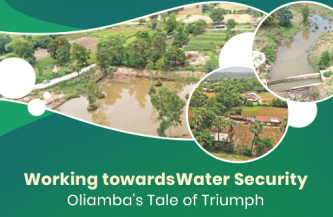Good Governance – Experiences Shared by MyGov Saathis

1) In 1992, the World Bank defined good governance in its report “Governance and Development” as- “The manner in which power is exercised in the management of a country’s economic and social resources for development. It laid out eight major characteristics of good governance. In that manner, good governance is democratic, consensus-driven, accountable, transparent, responsive, effective and efficient, equitable and inclusive, and adheres to the rule of law. It ensures that corruption is minimised, minorities’ perspectives are considered, and the voices of society’s most vulnerable are heard in decision-making. It is also responsive to society’s current and future needs.
One such initiative undertaken by the current government was e-governance, with its focus on ‘Minimum Government, Maximum Governance’. It has helped a lot of people, including me, since it saves a lot of time while we fulfill other engagements. The National e-Government Plan aims to make all government services available to the general public in his neighbourhood through common service delivery outlets, while also ensuring efficiency, transparency, and reliability of such services at reasonable prices. In the era of newly emerging information and communication technologies (ICTs), which herald new opportunities for rapid social and economic transformation around the world, e-government effectively delivers better programming and service. It has a direct impact on citizens, who benefit from direct interactions with government services. Several programmes under this include Pro-Active Governance and Timely Implementation (PRAGATI), Digital India Program, MCA21 (to improve the speed and certainty in the delivery of Ministry of Company Affairs services), provisions for online Income Tax Return, among others.
2) “It is easy to win elections by raising slogans of Garibi Hatao but slogans do not remove poverty.”
When Atal Behari Vajpayee said these words, he knew fully the importance of bringing people out from the mentality of poverty. He tried, with whatever wafer-thin majority he had, to march a billion strong nation out of distress. Sarva Shiksha Abhiyan was one such initiative. Atal ji tried to make Indians self-sufficient by educating them.
However, it would not be until the premiership of PM Narendra Modi that Indians would finally look towards a new horizon. When the world used to mock India for lack of sanitation facilities, PM boldly talked about the importance of hygiene from the ramparts of the Red Fort. Today, over 95% of Indians boast of a clean sanitation centre in their houses. At a time when banking was thought to be a facility for the rich, PM helped in maintaining bank accounts at zero balance. Contrary to what was hoped, banks have proven to be a national asset in disbursing loans, funds and compensations to people in need.
A strong nation is a successful nation only when social security is guaranteed along with national security. Mainstreaming alienated youths and consensus building in the past 7 years have proven to be successful in India and have also contributed to our diplomatic influence.
When the most deprived people feel secure, that is when you know good governance has been attained. When the people who have been systematically supressed for 75 years are at the government’s priority; that is when a nation can be proud of its Azadi ka Amrit Mahotsav. To kick off the largest vaccination drive in the world and by vaccinating more than 60% of the eligible population within 11 months is nothing short of a miracle. Just a demo of what we can achieve if the correct intentions, adequate resources and absolute resolve are put together.
3) “Our aim may be as high as the endless sky, but we should have a resolve in our minds to walk ahead, hand-in-hand, for victory will be ours.” -Atal Bihari Vajpayee
Good governance day is celebrated annually on 25th December to mark the birth anniversary of the former Prime Minister Atal Bihari Vajpayee. The aim is to create awareness of accountability in government among the citizens of India. Good Governance Day has been proclaimed a working day for the nation.
Kautilya in his treatise Arthasastra elaborated the traits of the king of a good governance state as “in the happiness of his subjects lies his happiness, in their welfare his welfare, whatever pleases himself, he does not consider as good, but whatever pleases his subjects he considers as good”. The concept of the philosopher king as the ideal ruler Aristotle was perhaps the first political theorist to deal with the term “governance”, when he classified political organizations by indicating the manner, in which they were ruled by a kind of numerical court of rule by one (dictatorship), a few (autocracy), or many (democracy).
Good governance can be defined in many ways, but in simple terms, “Good governance refers to systems of government that are capable, responsive, inclusive, and transparent. All countries, whether developed or developing, must continuously work towards better governance. Good or democratic governance requires meaningful and full political participation. Improving governance should involve giving more people a greater say in the decisions that govern their lives. It has 8 characteristics: It should be participatory, consensus-based, accountable, transparent, responsive, effective and efficient, equitable, inclusive and follow the rule of law.
I am a citizen of Bihar and come from a farming family. My uncle’s family lives in Dularpur village in Begusarari district. His family gets the advantage of The Pradhan Mantri Jan Arogya Yojana under which he is covered for health insurance and his family is also gets the Kisan Samman Yojana from which he receives ₹ 6000 per annum directly into his bank account. Under the Pradhan Mantri Krishi Sinchayee Yojana, he receives a grant of 75% of the amount spent on irrigation.
But the most beneficial scheme for his family is Sukanya Samriddhi Yojana under which his first granddaughter was registered in 2018. At the age of just 5 years, a bank account was registered in her name and an annual amount of 5000 was deposited. My uncle is not worried about her future, because my nephew wants to become a doctor and plans to use the investment for her future studies.
My family is actively participating in the government programs for good and effective governance, and they are grateful to the government.
4) In the past 7 years, the most happening year was 2019 when a unicellular virus – Corona Virus entered the ecosphere of humans unprecedentedly without any warning or alarm. During such challenging times, the quintessential role of every government was to keep their citizens safe and aware about the current happenings around their territory. Similarly, the Union government of India took a plethora of myriad measures to limit the spread of virus to the maximum extent possible. One such measure was the invention of the Aarogya setu app, which affected me and my family to a very large extent during two different waves of COVID-19 pandemic. In the first wave my father was covid positive and in the second wave my whole family including me were positive. Even after being positive, we did not have to panic much about the virus because we had all the guidance and information to tackle the virus through a one-stop solution – Aarogya Setu App. The app is so user friendly and hassle free that even during the second wave when doctors were difficult to approach, Aarogya setu app guided us in taking voluntary steps to eradicate the virus from our body effortlessly. The yoga videos, ayurvedic home remedies, helpline numbers, location of nearby hospitals and laboratories not just plummeted the impact of the virus on me and my family but even resuscitated us in the shortest possible span of time. Self-assessment and the number of positive cases in my surroundings help me in taking precautionary measures all the time because precaution is better than cure. The best thing about Aarogya setu app is that my father can plan his business travels easily by comfortably assessing the pandemic situation in the destinations by even sitting on his couch. Hence, Aarogya setu is one of the symbols of good governance initiatives which the union government was able to implement in the times of crisis where accountability and transparency were of utmost importance to each and every Indian.
[These are 4 different blogs collated as a single blog written by our MyGov Saathis, Saumya Agrahar, Shresth Tiwari, Shubham Kashyap and Sushant Jaswal respectively.]

















